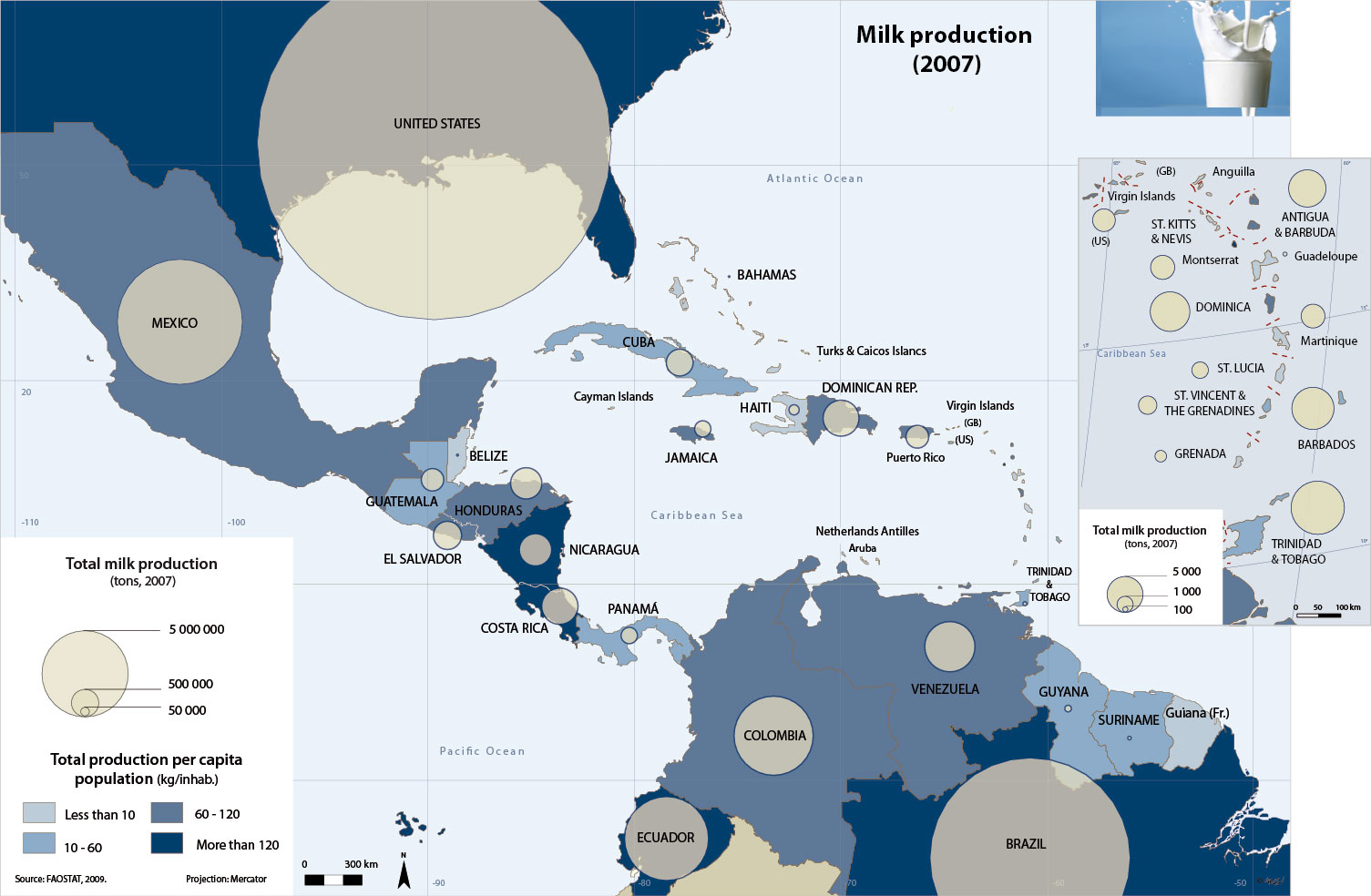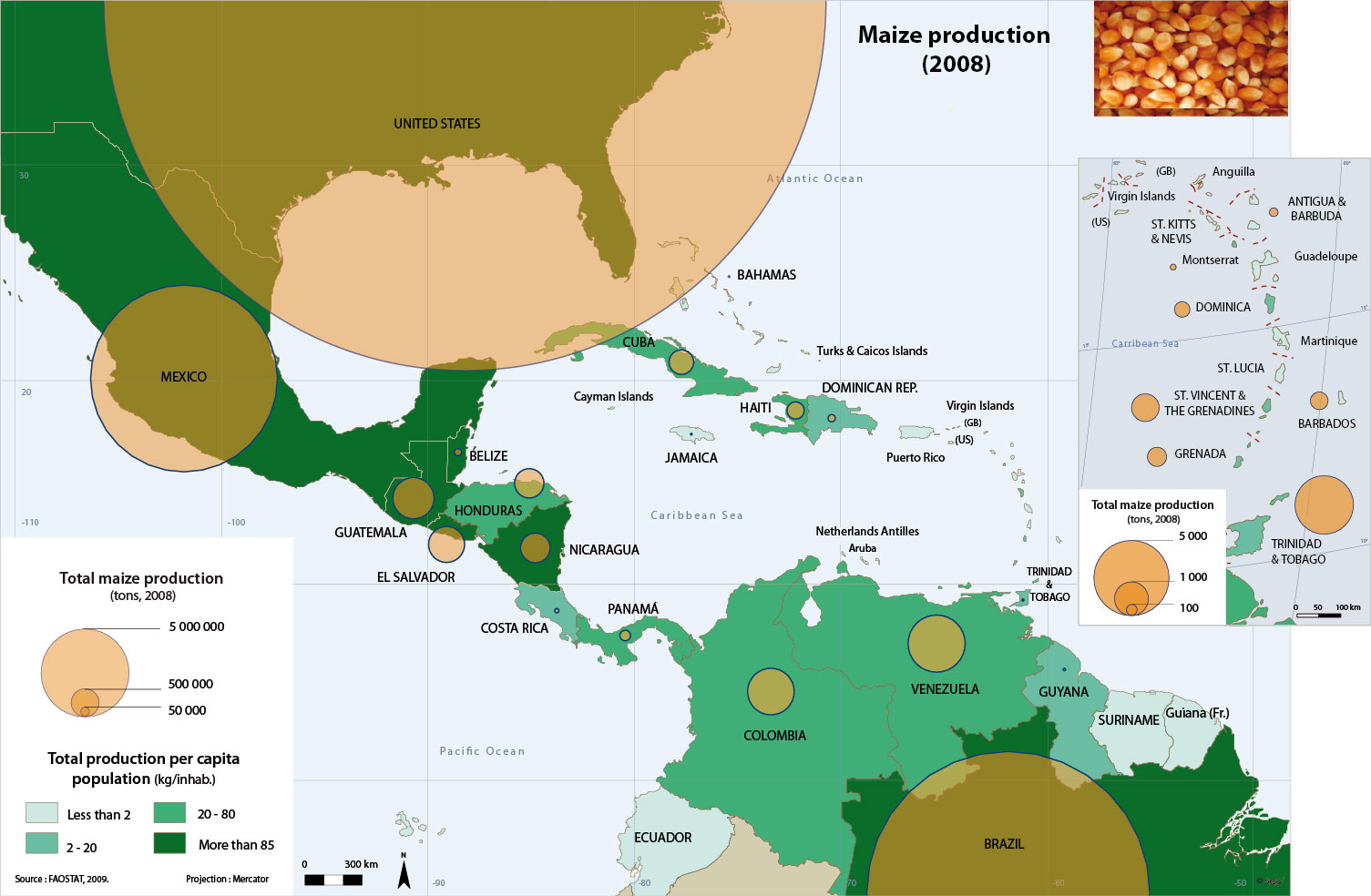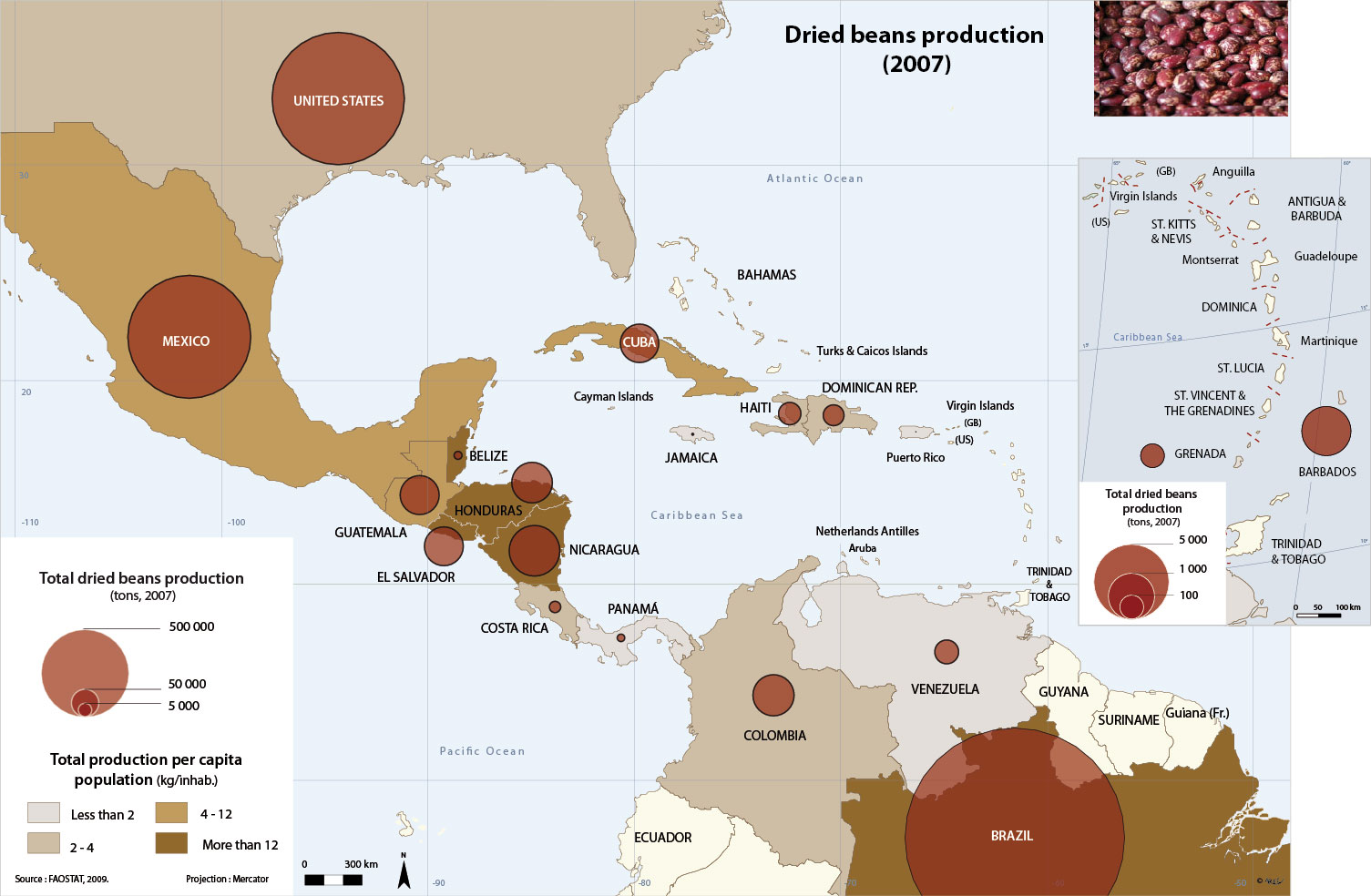
- Agriculture (2006-2009)
- Agriculture : mutation (2005-2006) FR ES
- Agriculture: emblematic landscapes
- Agriculture: food-self sufficiency (2005-2007)
- Agriculture: production (2007-2008)
- Commerce extérieur (2001) FR
- Currencies
- Economic organisations (2009)
- Fishing (1995)
- GNP per capita (1995)
- Integrated energy strategy (2004-2007)
- La Chine dans la Caraïbe FR
- La pêche dans le bassin Caraïbe - 2019 FR
- Le bassin caribéen, théâtre affirmé d'une guerre d'influence sino-étasunienne ? FR
- Nouveau contexte pétrolier (2015) FR
- Nouvelles donnes régionales (2004-2006) FR
- Sugar and Oil (1999-2011)
- Tax havens (2007-2010)
- Tax havens (2008-2012)
The countries of the isthmus are major producers and consumers of meat. Including all categories, some 72.8 million tons are produced with more than 57% of the regional total attributable to the United States alone. The Caribbean accounts for one quarter of the world's meat production (27%). The ready availability of land within the large mainland states explains and underpins these statistics. Conversely, small islands like the Virgin Isles, St. Kitts and Nevis, or even Montserrat and Dutch Antilles produce less than 100 tons per annum. The lack of land, more particularly in respect of stock rearing is clearly evident here. But when related to a country's total population, overall rankings are somewhat different. The United States remains in top position with 138 kg/inhabitant, followed by the island of Montserrat with more than 98 kg/inhabitant in 2007. In this case, the explanation lies not only in the very low population but also in the availability of stock: so if one considers solely the number of beef cattle, the latter total of 9 800 outnumbers the island's population (9 638 inhabitants). Brazil and Venezuela find themselves respectively in 3rd and 4th positions with more than 70 kg/inhabitant, followed by Barbados and Trinidad & Tobago with over 60 kg/inhabitant. In contrast, the Lesser Antilles, French Guiana, and the Dutch Antilles produce less than 10 kg/inhabitant. Across the whole zone, according to FAO data in 2007, the Caribbean only imported just 939 755 tons excluding imports from Mexico and the USA. This total rises to 4 million tons if the two latter states are taken into account, but still remains small in relation to the total production of the Caribbean, which stands out as a major stock rearing region and meat producer, even though not all countries attain the same level.
Milk is an essential foodstuff in a population's sustenance. In 2007, the Caribbean produced nearly 133 million tons, that is 19.6% of world production. As in the case of stock rearing dedicated to producing meat, dairy herds demand sufficient space and pasture to feed their needs. All the mainland countries clearly have the advantage by comparison to the small islands whose availability of land and water imposes constraints in the choice of agricultural options. The United States, Brazil, and again even Mexico head the list by volume of the main producing countries. The latter three alone account for 127 million tons of milk, i.e. 95.5% of the total produced across the region. All the countries, however, are milk producers, even when it only involves small quantities, as in Guadeloupe, French Guiana, or the Dutch Antilles, which total less than 500 tons per annum. By contrast, in terms of per capita production, it is small countries that stand out, so Montserrat comes in second position with 233.4 kg of milk per inhabitant, as against 277.1 kg for the United States. Equally, Costa Rica registers a sizeable return given that its inhabitants in theory dispose of some 212 kg each in 2007. Conversely, in the French Antilles the per capita total is less than 5 kg, including the extreme case of Guadeloupe with just 150 grams per inhabitant. Clearly, such totals do not represent actual volumes of milk available to the population in question; with imports compensating short falls in local production. Note however that the smallest producers are the three overseas French territories (Martinique, Guiana, and Guadeloupe) together with the Dutch Antilles.
Maize may appear at first to represent one of the region's main areas of agricultural production. The Caribbean overall alone accounts for more than 50% of world production, but the inclusion of the United States distorts the picture. As a truly global granary, it represents some 42% of world production. The Caribbean region strictly speaking represents only 10%. However, maize is an essential animal feed as well as food for human consumption. As in all cereal farming, with its major demands for both land and water, maize is grown particularly in the mainland states, Mexico, Brazil, Venezuela, Colombia, and Guatemala which together provide the quasi totality of production. Note that Haiti produced over 190 000 tons in 2007, whilst Cuba rivals the mainland states, producing more than 368 000 tons of maize. The small islands are clearly disadvantaged by comparison in this listing of major producers, penalised by both their lack of space and water. French Guiana, Montserrat, Antigua, Dominica, or Barbados thus produce only between 30 and 300 tons per annum. If per capita production alone is taken as the measure then certain countries stand out, as in the case of Belize with 127 kg/inhabitant or of El Salvador with nearly 118 kg/inhabitant. In contrast, Suriname, Puerto Rico, French Guiana, Jamaica, Antigua, or Barbados produced less than one kilo per head of population in 2007. It is very little when one considers that this crop traditionally represents a basic foodstuff for many countries across the region.
Bean production in the Caribbean region in 2007 rose to over 6 million tons, i.e. one third of world production. This relatively impressive total is once again augmented by US production (1.1 million tons) and that of Brazil (3.1 million tons). Even excluding these two countries, the Caribbean region still produces nearly 1.8 million tons of dried beans, i.e. 29.4% of world production. However, production is largely concentrated in the ‘major' countries of the region – Mexico, Nicaragua, Colombia, Guatemala, and Honduras. In each of the latter, production exceeds 100 000 tons in 2007. Not all countries produce this foodstuff, in fact only 19 of the 39 states in the region. The Lesser Antilles are all absent from the list, only the Greater Antilles and the mainland countries are producers and, as with maize cultivation, the islands are characterised by very low totals. As such Puerto Rico, Grenada, Jamaica, and Barbados produce less than 500 tons. In per capita terms, Nicaragua with 29 kg and Brazil with 16 kg per inhabitant, head the list. In contrast, Puerto Rico and Jamaica respectively produce only 1 to 9 kg per inhabitant.
A regional climate generally favourable to tomato cultivation has resulted in a total production of 22.8 million tons cultivated across the different countries of the Caribbean. The central characteristic of this particular crop activity is that it is found across the whole of the region. All the countries produce tomatoes, from the Cayman to Bermuda by way of Martinique, Jamaica, or Haiti, each producing a few tons. Even if this production represents only 17.6% of the world total, it provides for the daily needs of the region's population. Amongst the main producers, one inevitably finds the US, Brazil, and Mexico, together producing over 3 million tons. Cuba lies in fourth position followed closely by the Dominican Republic; indeed, these two countries record the highest per capita production totals, with the exception of the US. Cuba produces nearly 55 kg/inhabitant and the Dominican Republic 30 kg. A the other end of the scale come Haiti, Cayman Islands, or Grenada with less than one kilo per inhabitant in 2007.
top
|
  |

















